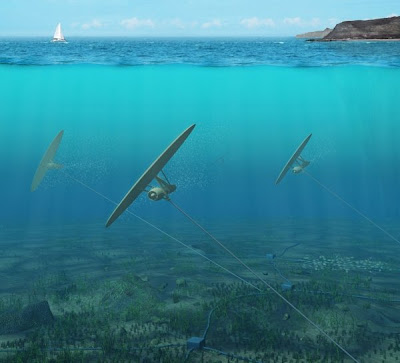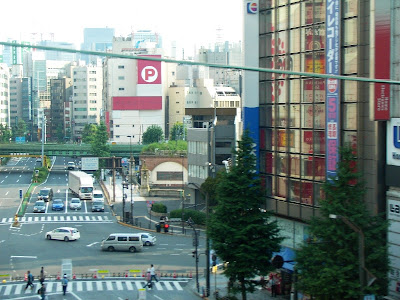Electricity and the Sea (L'électricité et la mer)
There are some fundamental conditions that have allowed Japan to succeed in industry and economy.
One of them is electricity or sufficient provision of electricity. But, due to strong requests by the government to carry out additional inspections of all the nuclear power plants in Japan, shortage of electricity has become a major social issue in Japan. Demands for electricity might exceed a total supply amount at least in a few hours of a hot day in the middle of the summer due to desperate needs of people for artificial cooling.
In the long term, Japan will have to find other resources for electricity generation that can replace nuclear fuel, since nuclear power generation, so far as now, accounts for 20 to 30% of the whole power production in Japan.
SECTION I: Tidal Power/Sea Power Generation
As there is a massive sea current in the south and east of the Japanese Archipelago, the tidal power generation is a big concern for some Japanese. The current, called Kurosio, flows at almost 7.4 km (4.5 miles) per hour. It keeps a velocity of about 2.5 km per hour at the depth of 600 to 700 meters.
http://blog.goo.ne.jp/mykaito/e/360e1ee58e149f34af4def82ba8b96b2
http://www.monogocoro.jp/2008/04/08/seagen.html
http://ameblo.jp/ghostripon/entry-10299954785.html
http://web.mit.edu/newsoffice/2008/waves-portugal-tt1217.html
http://www.atlantisresourcescorporation.com/media/news/1-latest/126-india-plans-asian-tidal-power-first.html
http://greenpost.way-nifty.com/softenergy/2009/07/200mwblue-energ.html
http://blogs.yahoo.co.jp/shelter55jp/61235764.html
http://www.youtube.com/watch?v=TTqRtwDTApU&feature=related
http://shadow-city.blogzine.jp/net/2011/04/post_763e.html
Even recently an old fisherman of Okinawa drifted due to a trouble of his fishing boat. Taking 20 days, he was carried over 1000 km near the south of the Japanese mainland. There he was rescued out of the Pacific Ocean. The current carried his failed boat all along the Japanese Archipelago from the south to the north, at 50 km per day.
The Kuroshio (Japanese: "Black Tide") is a strong western boundary current in the western north Pacific Ocean.
It begins off the east coast of Taiwan and flows northeastward past Japan, where it merges with the easterly drift of the North Pacific Current. It is analogous to the Gulf Stream in the Atlantic Ocean, transporting warm, tropical water northward towards the polar region...
The Kuroshio is a warm current (24°C annual average sea surface temperature), about 100 km wide and produces frequent small to meso-scale eddies. The Kuroshio Current is ranked as a moderately high productivity ecosystem (150-300 gCm−2y−1) based on SeaWiFs global primary productivity estimates. The coastal areas are highly productive and the maximum chlorophyll value is found around 100 meters depth.
http://en.wikipedia.org/wiki/Kuroshio_Current
http://www.jamstec.go.jp/recruit_01/projects/project02/
*** *** *** ***
Most of Europeans and Americans are surprised to know that Japan is the largest creditor country in the world.
Japan does not borrow money from the U.S., the U.K., Germany, China, or any other countries.
Japan has more than $3 trillion foreign assets as of 2010, including more than $1.1 trillion U.S. Treasury bonds.
As the American/English media and economists predicted in these 15 years that Japan would go bankrupt due to huge financial deficits, most of Europeans and Americans have come to think that Japan has no foreign assets. But it is a big misunderstanding. Japan is the largest creditor country in the world. And, most of Europeans and Americans are surprised that China has suddenly become a global economic power. But, it is Japan that has been investing capital and transferring technology to China in these decades to make it grow as a large market.
(The Japanese governmental financial problem is that the government spends more than the revenue from tax it has collected. The Japanese Government has issued a huge amount of bonds, however, which have been all purchased by domestic banks and so on. Within Japan, debts and credits are balanced between the Government and the private sector.)
While the American/English media and economists have been predicting in these 15 years that Japan would go bankrupt due to huge financial deficits, the 9/11 Terror occurred, the Enron scandal occurred, the subprime-loan triggered Wall Street crisis occurred, the GM bankruptcy occurred, and an European financial crisis is now occurring.
What I want to point to is that there is something inherently wrong in the American/English media and economists. Probably, they are trying to help rich Europeans and Americans continue to enjoy their status while leading poor Europeans and Americans to a very wrong direction. And, there is even a suspicion that they are boosting Chinese ego in their bubble-like monetary activities in the market in New York and London to eventually take a big byte on Chinese money.
Maybe, the final solution is to close the money market in New York and London and overhaul the American/English media and economists.
Luk 7:16 And there came a fear on all: and they glorified God, saying, That a great prophet is risen up among us; and, That God hath visited his people.















































